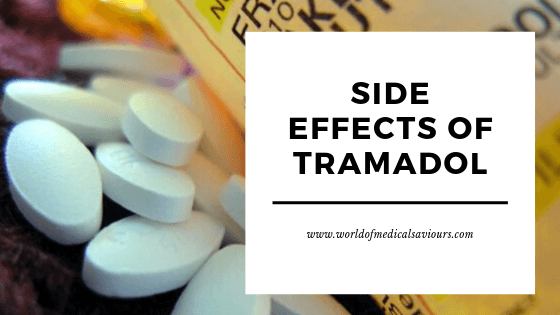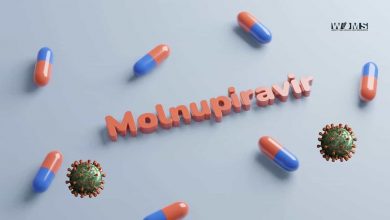Side effects of Tramadol

Tramadol is a medicine that can be used by people who are suffering from moderate or severe pain. Before using it, there are certain things that you should know about medicine like its dosages, indications, side effects of tramadol, dosage formulation and many more.
This centrally acting analgesic is an atypical opioid which relieves pain by opioid as well as additional mechanisms. Its affinity for µ opioid receptor is low, while that for κ and δ is very low. Unlike other opioids, it inhibits the reuptake of NA and 5-HT, increases 5-HT release, and thus activates monoaminergic spinal inhibition of pain. Its anodyne action is only partially reversed by the opioid antagonist naloxone.
Inoculate 100-milligram Intravenous tramadol which has same dosage effect as 10 mg intramuscular morphine. The oral bioavailability of 319 pills is good (oral: parenteral dose ratio is 1.4). The t½ is 5–6 hours and possessions last for 4–6 hrs.
Tramadol compels less respiratory depression, sedation, constipation, urinary retention and a rise in intra-biliary pressure than morphine. It is well tolerated; side effects of tramadol are dizziness, nausea, sleepiness, dry mouth, sweating and lowering of seizure threshold. Hemodynamic effects are minimal. Tramadol should not be given to patients taking SSRI therapy because of the risk of ‘serotonin syndrome’.
Tramadol is indicated for mild-to-moderate short-lasting pain due to diagnostic procedures, affliction, operation, etc, as well as for chronic pain including cancer pain, but is not efficient in severe pain. Little tendency to dose escalation by chronic users is seen and abuse potential is low.
Side effects of tramadol
Tramadol oral tablet may cause apathy. You should not drive, use heavy machinery, or perform any dangerous activities until you know how these drugs affect you. Tramadol may also cause other side effects.
More common side effects
The more common side effects of tramadol can include:
- Dizziness
- Headache
- Drowsiness
- Nausea and vomiting
- Constipation
- Lack of energy
- Sweating
- Dry mouth
If these effects are mild, they may fade away within a few days or a couple of weeks. If they’re more severe or don’t go away, talk to your doctor about it.
Serious Side effects
Visit your doctor right away if you have serious side effects of tramadol. Serious side effects and their symptoms can include the following:
Serotonin syndrome. Symptoms can include:
- Fast heart rate
- High blood pressure
- Higher body temperature
- Reflexes that are stronger than normal
- Lack of coordination
- Nausea and vomiting
- Diarrhea
- Hallucinations
- Coma
Serious breathing problems. Symptoms can include:
- Slow breathing rate
- Very shallow breathing
- Fainting, dizziness, or confusion
Physical dependence and withdrawal when stopping the drug. Symptoms can include:
- Feeling irritable, anxious or restless
- Trouble sleeping
- High blood pressure
- Fast breathing rate
- Fast heart rate
- Dilated pupils
- Teary eyes
- Runny nose
- Yawning
- Nausea, vomiting, and a loss of appetite
- Diarrhea and stomach cramps
- Sweating
- Chills
- Muscle aches, back pain, or joint pain
Adrenal insufficiency Symptoms can include:
- Long-lasting tiredness
- Muscle weakness
- Pain in your abdomen
- Androgen deficiency. Symptoms can include:
- Tiredness
- Trouble sleeping
- Weakness
Seizures
Addiction or misuse of this drug
Disclaimer: Our goal is to provide you with the most relevant and current information. However, because drugs affect each and every person differently, we cannot guarantee that this information includes all possible side effects of tramadol. This information is not an alternative for medical advice. Always discuss the possible side effects of tramadol with a doctor who knows your medical history very well.
Precautions
Use cautiously in Geriatric patients ( not to exceed 300 mg/ day in patients >75 years). Patients with a history of epilepsy or risk factors for seizures, renal impairment, hepatic impairment, contraindicated in patients who are physically dependent or intoxicated with alcohol, sedative, centrally acting analgesics, or psychotropic agents.
Drug Interaction
Increased risk of convulsions or serotonin syndrome w/SSRI, serotonin-norepinephrine reuptake inhibitors (SNRI), TCA and other seizure threshold lowering drugs (e.g. bupropion, mirtazapine, tetrahydrocannabinol). Decline serum concentrations w/carbamazepine. May potential the anti-depressant effect of norepinephrine, 5-HT agonists Orlithium. Increased INR and ecchymoses w/coumarin derivates (e.g warfarin). Potentially Fatal: Increased risk of seizures and serotonin syndrome w/MAOIs.
What medications should not be taken with tramadol?
View interaction reports for tramadol and the medicines listed below.
- Advil (ibuprofen)
- Aleve (naproxen)
- Ambien (zolpidem)
- Aspirin
- Aspirin low strength (aspirin)
- Benadryl (diphenhydramine)
- Celebrex (celecoxib)
- Cymbalta (duloxetine)
Summary
Tramadol is known as opioid medications used to treat moderate to moderately severe pain. It is available in both oral and injectable forms. It may be sold in combination with paracetamol or as a longer-acting formulation. In this article, we read about the common side effects of tramadol and also about the serious side effects of tramadol.
It is not recommended in those who are at risk of suicide or in those who are pregnant. While not recommended in women who are breastfeeding, those who take a single dose should not generally stop breastfeeding.




